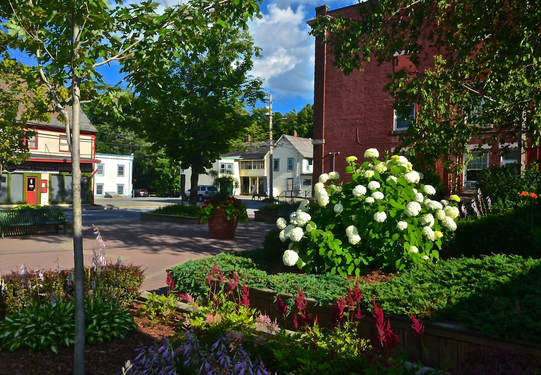ABOUT THE ROUTESThe Mount Ascutney Regional Commission is pleased to provide this guide to encourage residents and visitors to explore our region by bicycle. The guide provides both maps and narrative descriptions of 19 ideal cycling routes. All of the maps identify the towns and villages they pass through, so routes may be selected by location using the individual map panes or the area overview map.
Routes are identified by yellow or orange lines—solid lines denote paved routes while dashed lines denote unpaved routes. Each route passes through multiple towns and villages, and while they may be started anywhere along the route, likely parking areas are denoted with a parking icon. Open circles on the route lines signify mile markers—simply count the number of circles on the route between your current location and your destination to calculate distance. Bike shops, food, ice cream, breweries and taverns, swimming holes, and covered bridges are all identified on the maps with corresponding icons. Areas with potentially steep grades and rail road crossings are also identified on the maps. Turn-by-turn cue sheets, GPS tracks, and digital routes via Strava® are available on the 'The Routes' tab of this website for each route. You'll also find printable maps for each route (remember; there are plenty of areas along these rides where there is no cell service). |
Disclaimer
Notice to Bicyclists: The maps referenced in this website and accompanying information is intended solely to assist bicyclists in their selection of facilities to ride on throughout Windsor County. In providing this information, Mount Ascutney Regional Commission (MARC) does not designate these facilities as formal bikeways. MARC also does not assume liability for bicyclists who choose to travel upon any of the facilities shown on this map, nor does MARC guarantee the stability, condition or fitness of any of the listed facilities for bicycling. Many of the facilities identified on this map cross and/or run on public roads that are exposed to daily wear and tear and degradation due to weather, motorized traffic and other environmental factors. Facilities may contain pavement imperfections, including ruts, cracks, and bumps. Riders may encounter expansion joints, debris, encroaching vegetation, stormwater inlets, and other natural and man‑made features. Riders should also remain alert for areas of visual impairment and other irregularities that may impact rider and motorist ability to see each other or potential road hazards. The chance that one may come into an area of visual impairment or a route irregularity warrants special care on the part of route users. This map includes facilities within multiple jurisdictions. Conditions and design elements may vary between jurisdictions. It is the responsibility of the individual rider to remain alert at all times as to the conditions of the facility, pedestrian and other traffic on the facility, and the inherent potential for conflict in any shared-use space. Riders should always ride with care for their own safety as well as the safety of all other users of the facility or right-of-way
Credits
The Mount Ascutney Regional Commission would like to thank all those involved with creating this guide, including our stakeholder group of area cyclists, our partners at the Chambers of Commerce, and our consultants (SE Group and Path Less Pedaled). We would also like to thank our funders. This map was developed with funding from the Vermont Agency of Transportation and Vermont Agency of Commerce and Community development.
Links |



